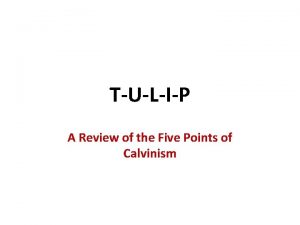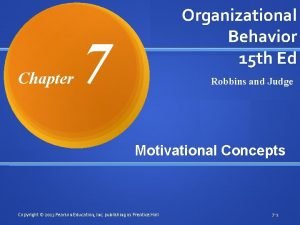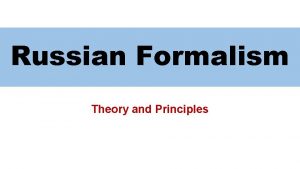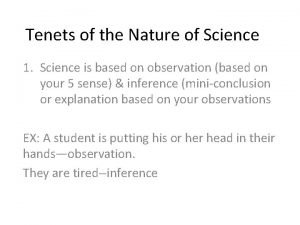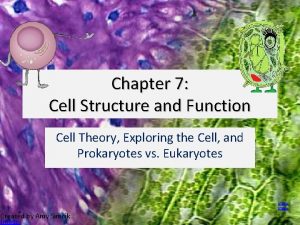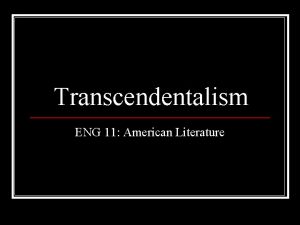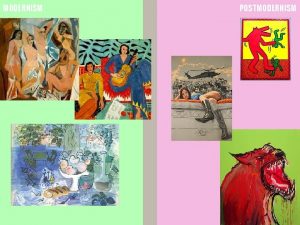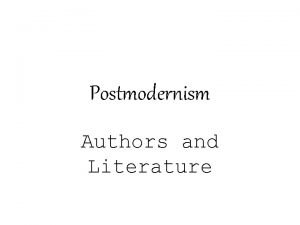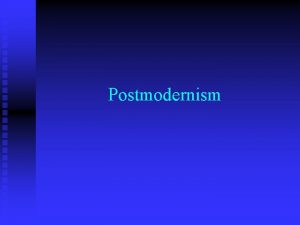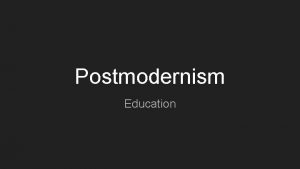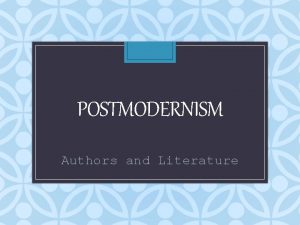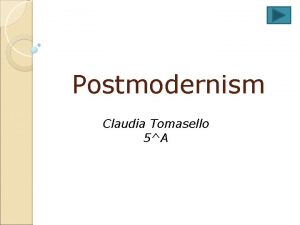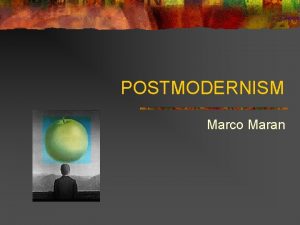Introducing POSTMODERNISM Tenets of Postmodernism 1 Extreme selfreflexivity










- Slides: 10

Introducing… POSTMODERNISM

Tenets of Postmodernism 1) Extreme self-reflexivity: objectification of structure; artist/author reflects upon own processes of creation • pomos more so than mods • more playful, irreverant • Examples: The Scream series of movies has characters debating the generic rules behind the horror film. Frank Gehry, Nationale-Nederlanden Buildi

Tenets of Postmodernism 2) irony and parody sense of playfulness DROWNING GIRL Roy Lichtenstein (1963)

Tenets of Postmodernism 3) A breakdown between high and low cultural forms. Modernism: focus upon “high” art Pomo: embraces both “high” and “low” arts (like comic books) Pomos often employ pop and mass-produced objects in more immediately understandable ways, even if their goals are still often complex (eg. Andy Warhol's commentary on mass production and on the commercial aspects of "high" art through the exact reproduction of a set of Cambell's Soup cans ). 200 Campbell’s Soup Cans

Tenets of Postmodernism 4) Nostalgia as pastiche: - Postmodernists and postmodern culture tend to be especially fascinated with styles and fashions from the past. - Often use completely out of their original context, and in juxtaposition = pastiche. - May be a symptom of our loss of a connection with the past….

Tenets of Postmodernism 5) Visuality (visuals, pictures) vs. temporality (linear time) 5) - Gravitation towards visual forms, as in the "cartoons" of Roy Lichtenstein or Art Spiegelman's Maus. - A general breakdown in narrative linearity and temporality. Many point to the style of MTV videos as a good example.

Tenets of Postmodernism 6) Disorientation: Pomo works attempt to disorient the subject in time and space. alternating narrators (Faulkner) fragmented chronology (Vonnegut) Dr. Who

It’s Pomo… You know, Post -modern… Weird for the sake of weird. Modernism = subjective truth Postmodernism = multiple truths and multiple subjectivities (Episode “Homer the Moe”)

Tenets of Postmodernism 7) Late capitalism: a general sense that the world has been so taken over by the values of capitalist acquisition that alternatives no longer exist. Predominance of paranoia narratives in pop culture (Bladerunner, X-Files, the Matrix, Minority Report). Aided by advancements in technology, especially surveillance technology the sense that we are always being watched.

Tenets of Postmodernism 8) Secondary Orality: reliance of a largely functionally illiterate society upon oral media sources for information (TV, radio, film, etc. ) reversal: literacy rates had been rising steadily from the introduction of print through the modern period, but postmodern society has seen a drastic reversal in this trend -- pomo culture still relies on print to create these media outlets (hence the term secondary orality); however, increasingly only a professional, well-educated class has access to full print- and computer-literacy. An ever larger percentage of the population merely ingests orally the media that is being produced (passive response).
 Extreme wide shot also known as
Extreme wide shot also known as Tenets of existentialism
Tenets of existentialism Tenets of operation chevron
Tenets of operation chevron 5 tenets of calvinism
5 tenets of calvinism What are the key tenets of expectancy theory?
What are the key tenets of expectancy theory? Russian formalism شرح
Russian formalism شرح Tenets of science
Tenets of science Tenets of kinetic molecular theory
Tenets of kinetic molecular theory Tenets of cell theory
Tenets of cell theory Transcendentalism examples in literature
Transcendentalism examples in literature Tenets of anarchism
Tenets of anarchism



